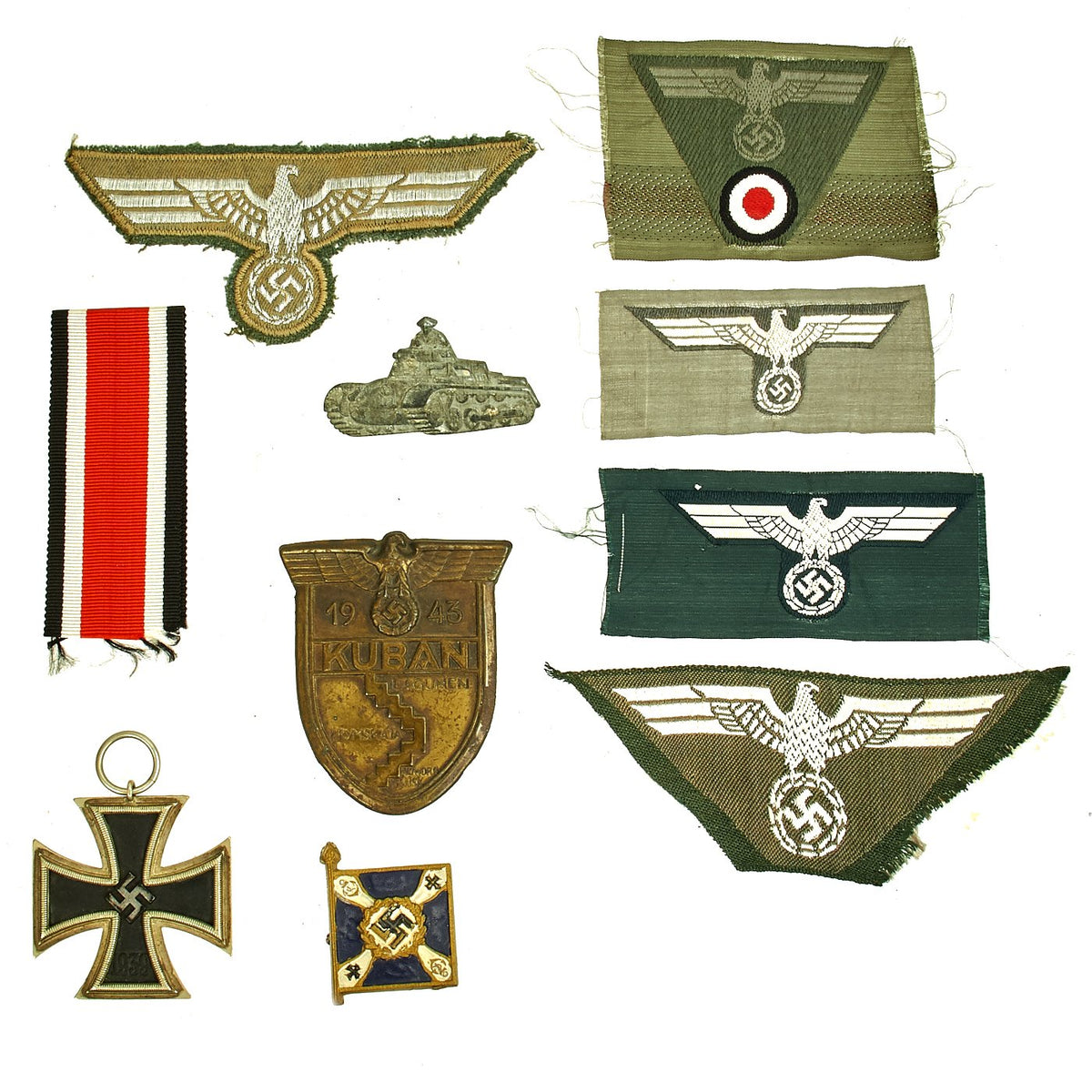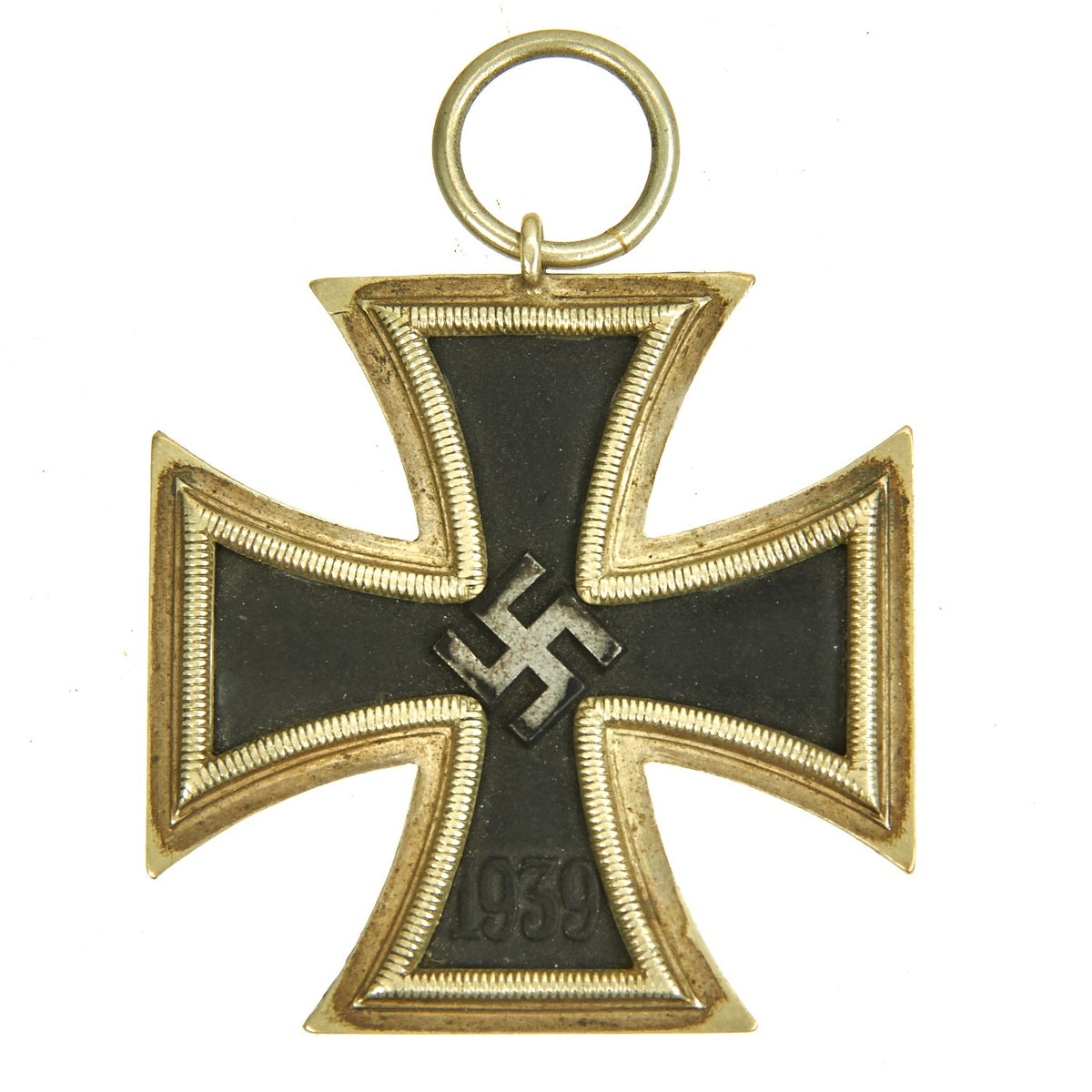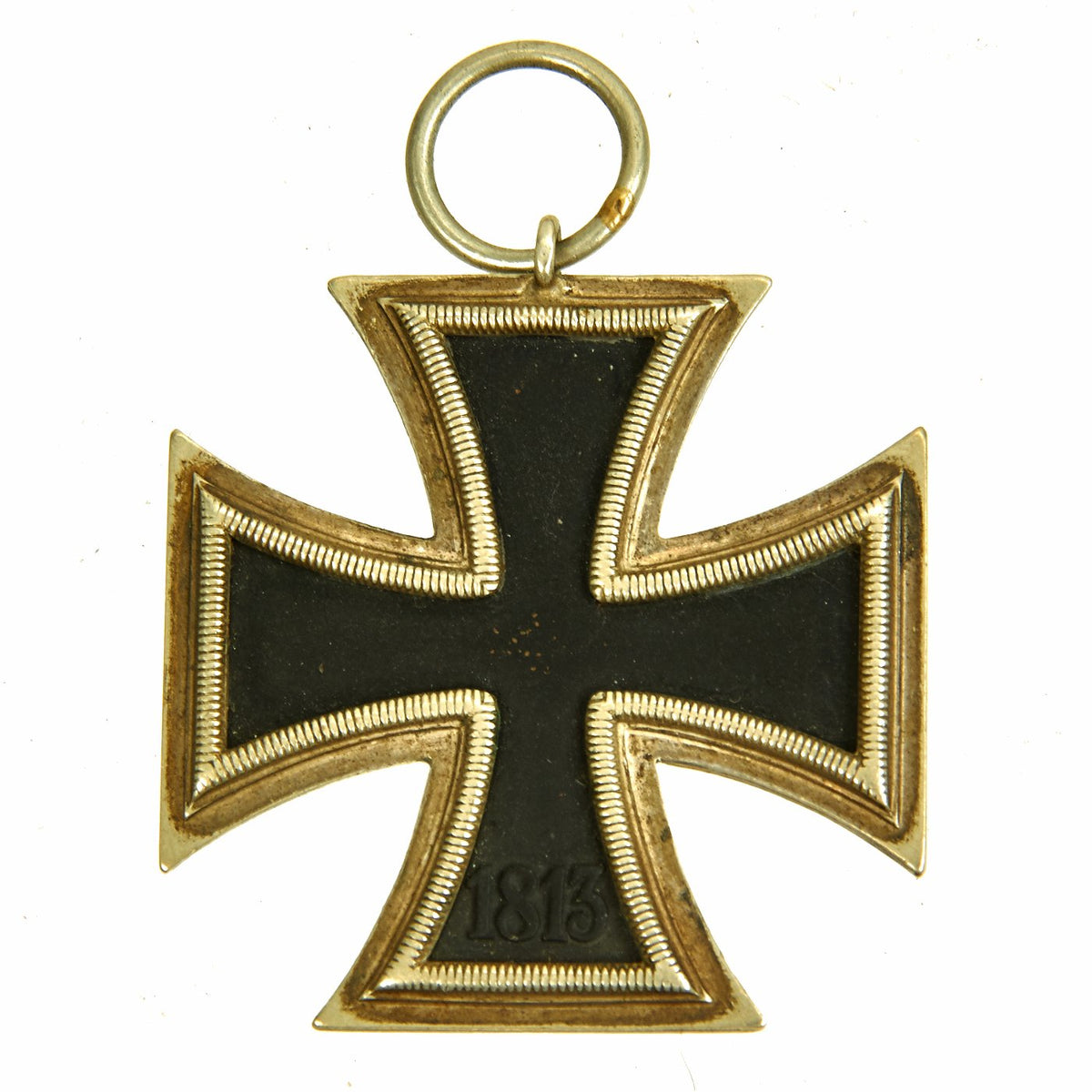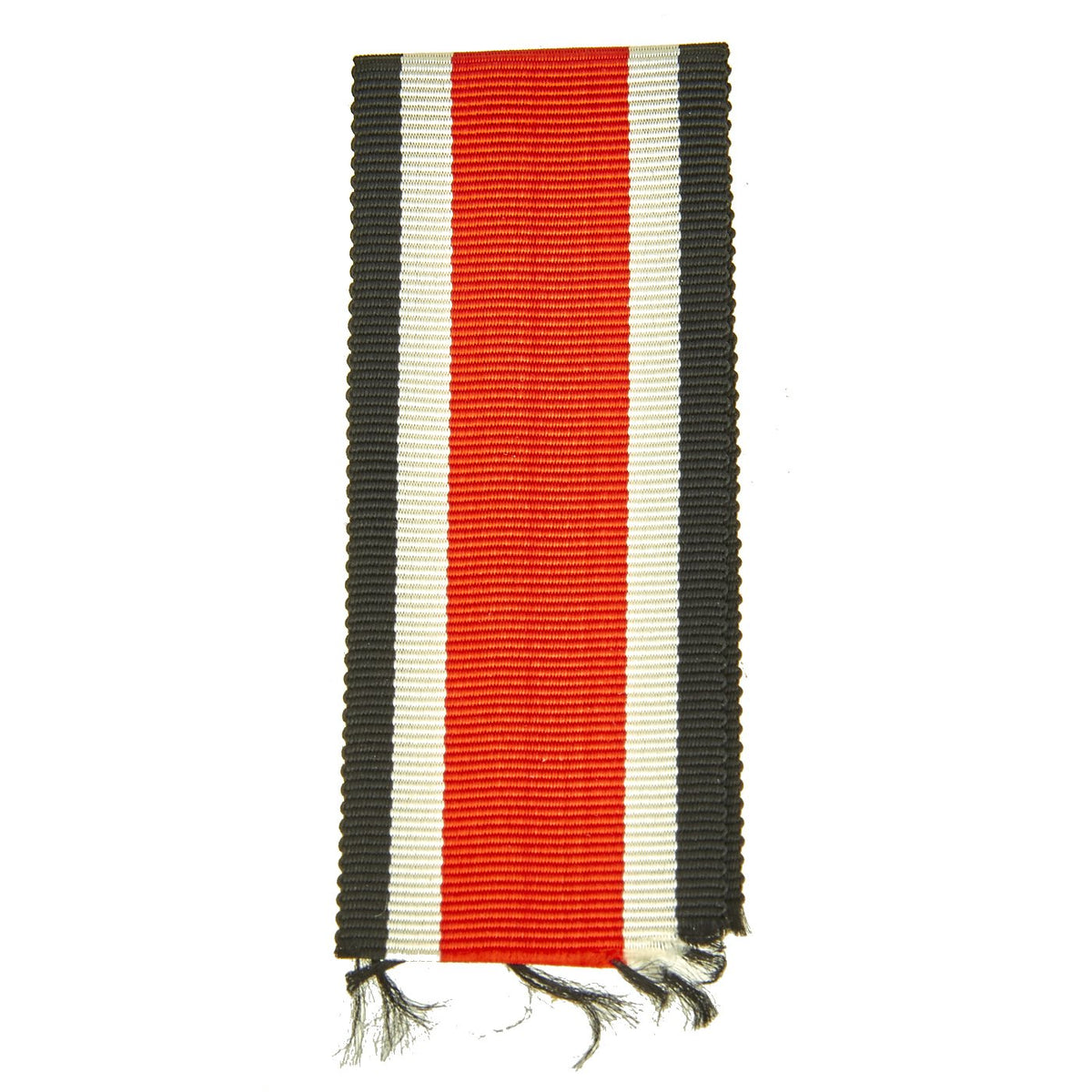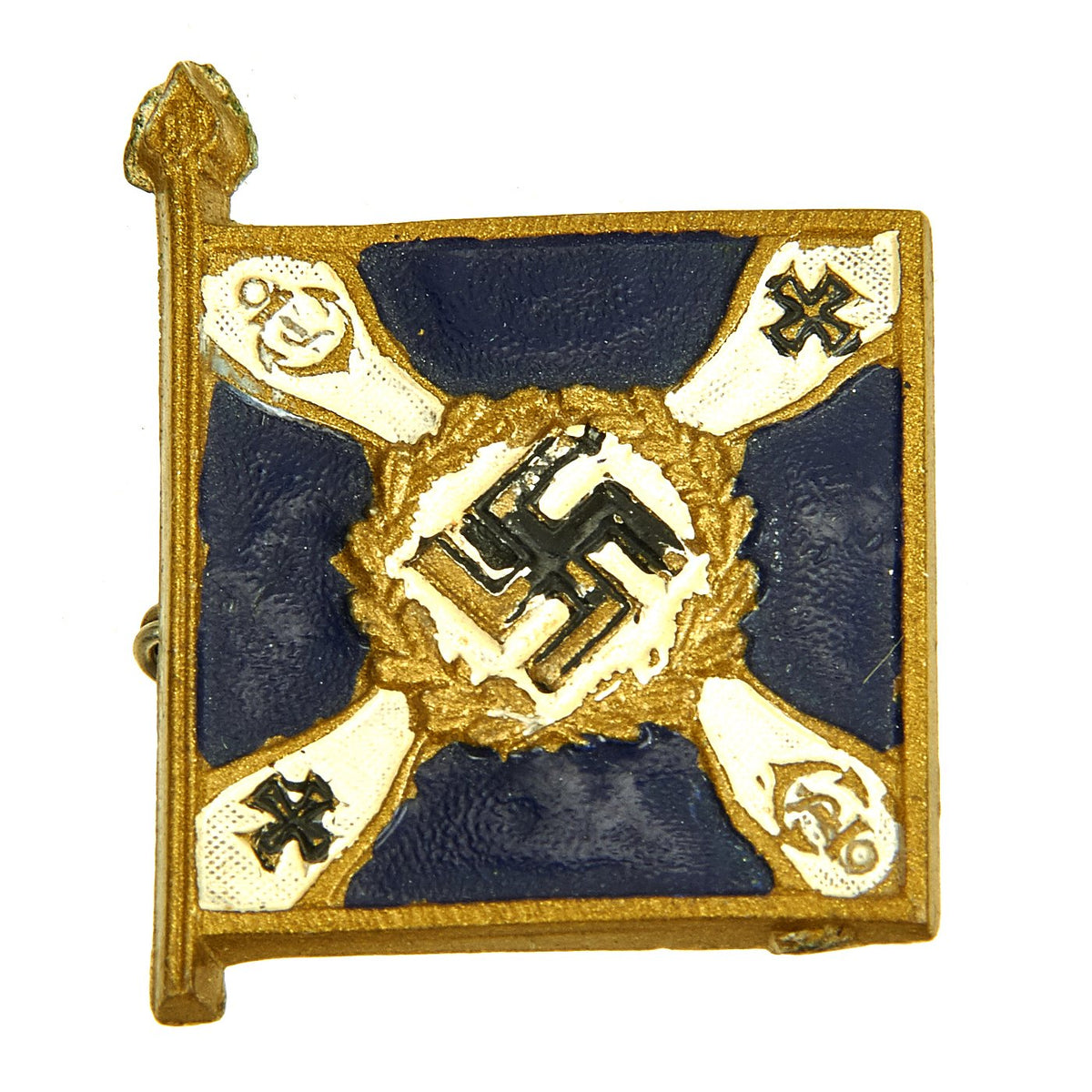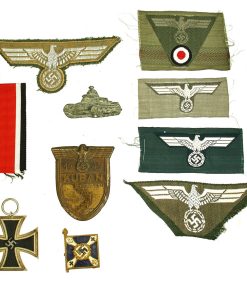Original German WWII Heer Army Officer Insignia & Medal Grouping with Iron Cross 2nd Class & Kuban Shield Original Items
$ 350,00 $ 105,00
Original Items: Only One Set Available. This is a very nice collection of German WWII Insignia, which was brought back from the European theater by a USGI after the war was concluded. It includes some lovely Army Heer Insignia, as well as several medals, including an Iron Cross 2nd Class and a Kuban Shield.
This lovely set includes:
– One Unissued German WWII BeVo Embroidered Army Officer’s Breast Eagle Insignia. This is a lovely example of the Reichsadler (national eagle) used on the front of Army Officer Tunics. It is stitched to the correct field gray wool, and is a lighter olive color, with a machine made eagle woven from silver threads, for an officer.
– One German WWII Iron Cross 2nd Class 1939 (Eisernes Kreuz II. Klasse 1939) with Ribbon. This fine example is in very good condition, and is maker marked 25 on the hanger ring, for Arbeitsgemeinschaft der Graveur-Gold-und Silverschmeide-Innungen in Hanau Germany.
– One German WWII 1943 Heer Kuban Bridgehead Shield Decoration – Ärmelschild Kuban. This example is missing the fabric backing and securing pin, and of the four clips used to secure it, only one remains. The front is in good shape, but the rear has some oxidation.
– THREE Unissued German WWII BeVo Embroidered Uniform Sleeve Eagles. These three are of varying styles, but are all the correct color and size for installation onto the sleeve of the uniform.
– One German WWII Heer Bevo Cap Eagle and Cockade Insignia. This would be attached to the front of an M43 Field cap or M38 Overseas cap, and was one piece, which saved time during manufacture and installation. Earlier war example had the eagle and cockade as two pieces.
– One German WWII Kriegsmarine Marineteile am Lande Tinnie. This translates to “Marine Parts on Land”, and was most likely given in recognition for donation to the Kriegsmarine war fund.
– One German WWII Armored Vehicle Pin. These were usually given out when soldiers managed to destroy an armored vehicle.
A wonderful totally genuine grouping perfect for the WWII German Afrikakorps collector.
There is no more iconic German military award than the Iron Cross. The long history of this order began during the Napoleonic Wars. King Friedrich Wilhelm III of Prussia instituted the Eisernes Kreuz (Iron Cross) in March of 1813. The award criteria changed somewhat with time, but generally speaking, Iron Crosses could be awarded for individual acts of bravery, or for leadership achievements on the battlefield. The design was created by a Karl Friedrich Schinkel, his choice of the black cross with silver outline was derived from the heraldic emblem of the Teutonic Knights.
The final reinstitution of the cross came in 1939. For this version, the front of the core for both grades bore a swas and the date 1939. The oak leaves, crown and royal initials were removed from the reverse, with only the date 1813 remaining as a reminder of the legacy of this award. In WWII, hundreds of thousands of Iron Cross First Class awards were bestowed, and four and a half million Iron Cross Second Class awards. Iron Crosses were made by a large number of authorized manufacturers. Some variants of these awards were mass produced in huge numbers. Others were made in very limited quantities.
Please also note the edge seam for authentication, which is not present on reproductions. Iron crosses were commonly constructed from an iron core sandwiched in a surrounding two part silver frame, normally the seam of these two silver parts is visible around the edge of the cross as is seen on this fine example.
The Kuban Shield (Ärmelschild Kuban) was a World War II military decoration of NSDAP Germany, awarded to those who fought at the Kuban bridgehead in the Soviet Union from February 1943 until it was abandoned in October 1943. The award was instituted on 21 September 1943
The shield is designed in a similar fashion to the Crimea Shield and was struck in sheet metal or zinc and treated with a bronzed wash. It features a German eagle with outstretched wings clutching a laurel wreath with a swas. On each side the wreath are the numbers 19 and 43. Directly below the eagle is written KUBAN in block capital letters. Below this name is a stylized map of the Kuban region, with a line representing the defensive line that the men fought to preserve with the location of the bridgeheads – KRYMSKAJA, LAGUNEN, and NOWOROSSIJSK.
The shield was worn on the upper left sleeve of the tunic. A back plate, which held in place a piece of cloth matching the recipients’ branch of service, was applied to the shield:
– Field Gray for Heer (army)
– Blue for Luftwaffe (air force)
– Black for Panzer units (armoured units)
The criteria for award of the shield to military personnel: Served in the bridgehead for 60 days; been wounded while defending the bridgehead; or Had been engaged in a single major operation at the bridgehead.
Fast Shipping with Professional Packaging
Thanks to our longstanding association with UPS FedEx DHL, and other major international carriers, we are able to provide a range of shipping options. Our warehouse staff is expertly trained and will wrap your products according to our exact and precise specifications. Prior to shipping, your goods will be thoroughly examined and securely secured. We ship to thousands clients each day across multiple countries. This shows how we're dedicated to be the largest retailer on the internet. Warehouses and distribution centres can be located throughout Europe as well as the USA.
Note: Orders with more than one item will be assigned a processing date depending on the item.
Before shipping before shipping, we'll conduct a thorough inspection of the items you have ordered. Today, the majority of orders will be delivered within 48 hours. The delivery time will be between 3-7 days.
Returns
The stock is dynamic and we cannot completely manage it because multiple stakeholders are involved, including our factory and warehouse. So the actual stock may alter at any time. It's possible that you may not receive your order once the order has been made.
Our policy is valid for a period of 30 days. If you don't receive the product within 30 days, we are not able to issue a refund or an exchange.
You can only return an item if it is unused and in the same state as the day you received it. You must have the item in its original packaging.
Related products
Uncategorized
Uncategorized
Uncategorized
Uncategorized
Uncategorized
Australian WWII Owen MK1 Machine Carbine SMG Custom Fabricated Replica with Sling Original Items
Uncategorized
Uncategorized
Uncategorized
Uncategorized
Uncategorized
Uncategorized
Armored Burgonet Helmet & Polearm from Scottish Castle Leith Hall Circa 1700 Original Items
Uncategorized
Uncategorized
Uncategorized
Uncategorized
Uncategorized
